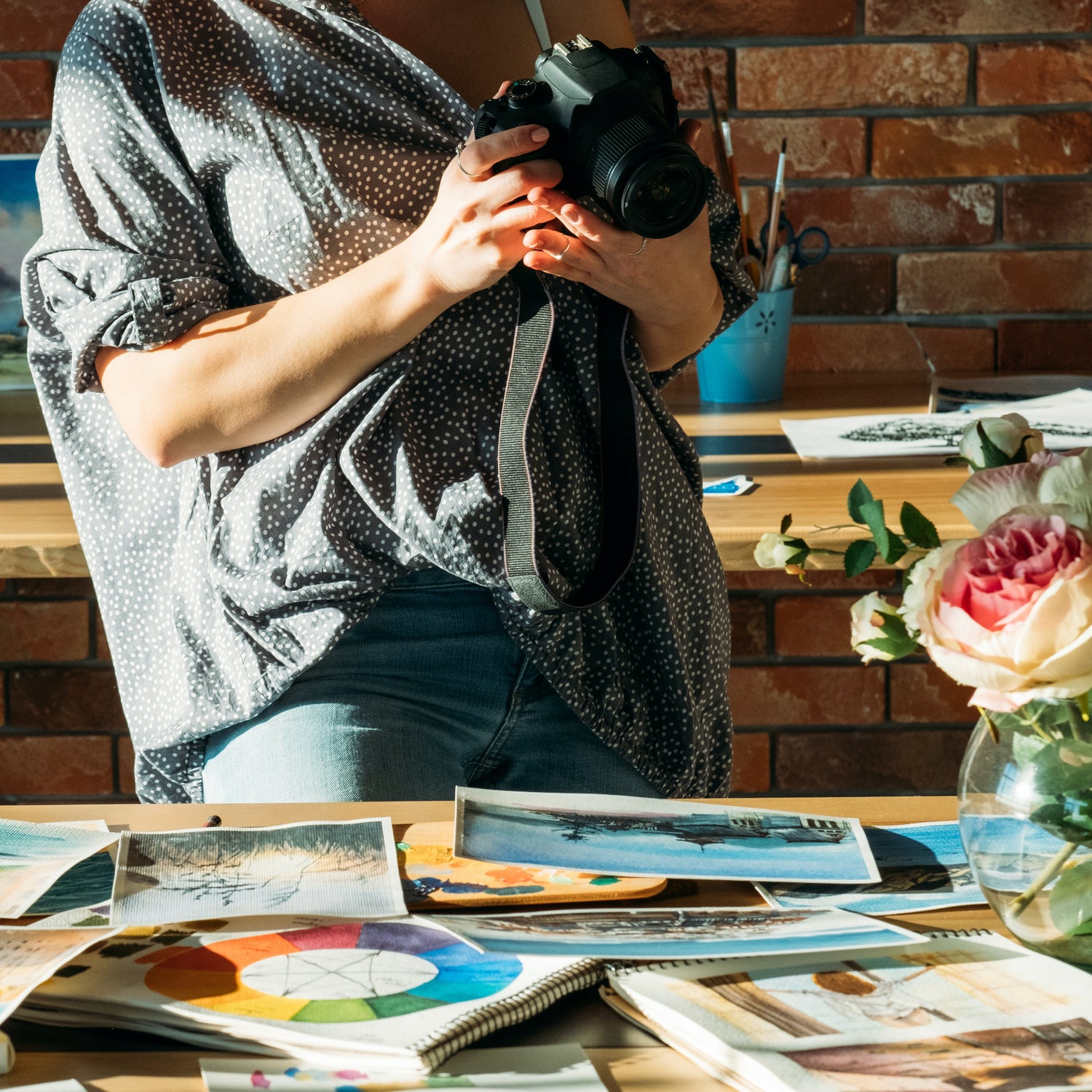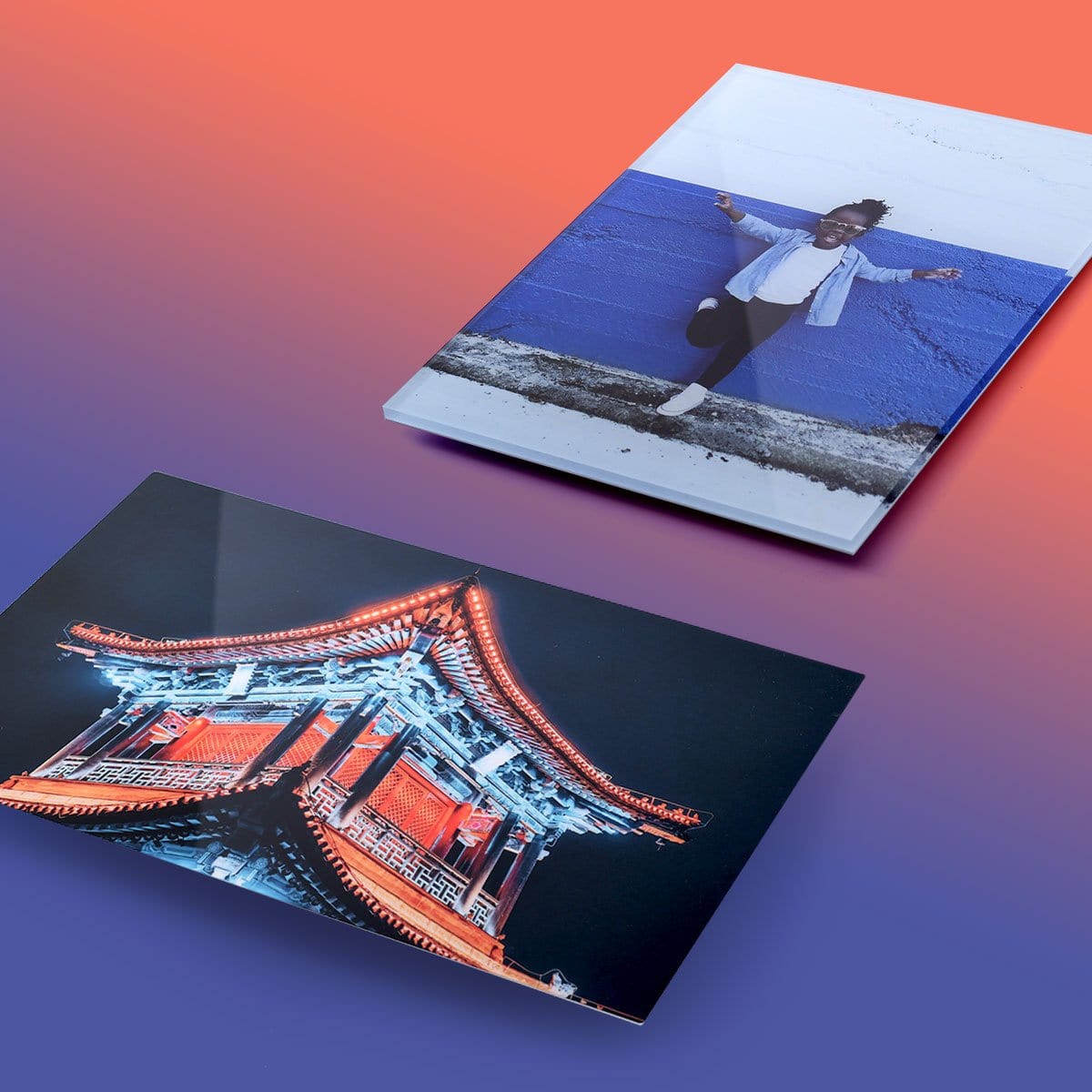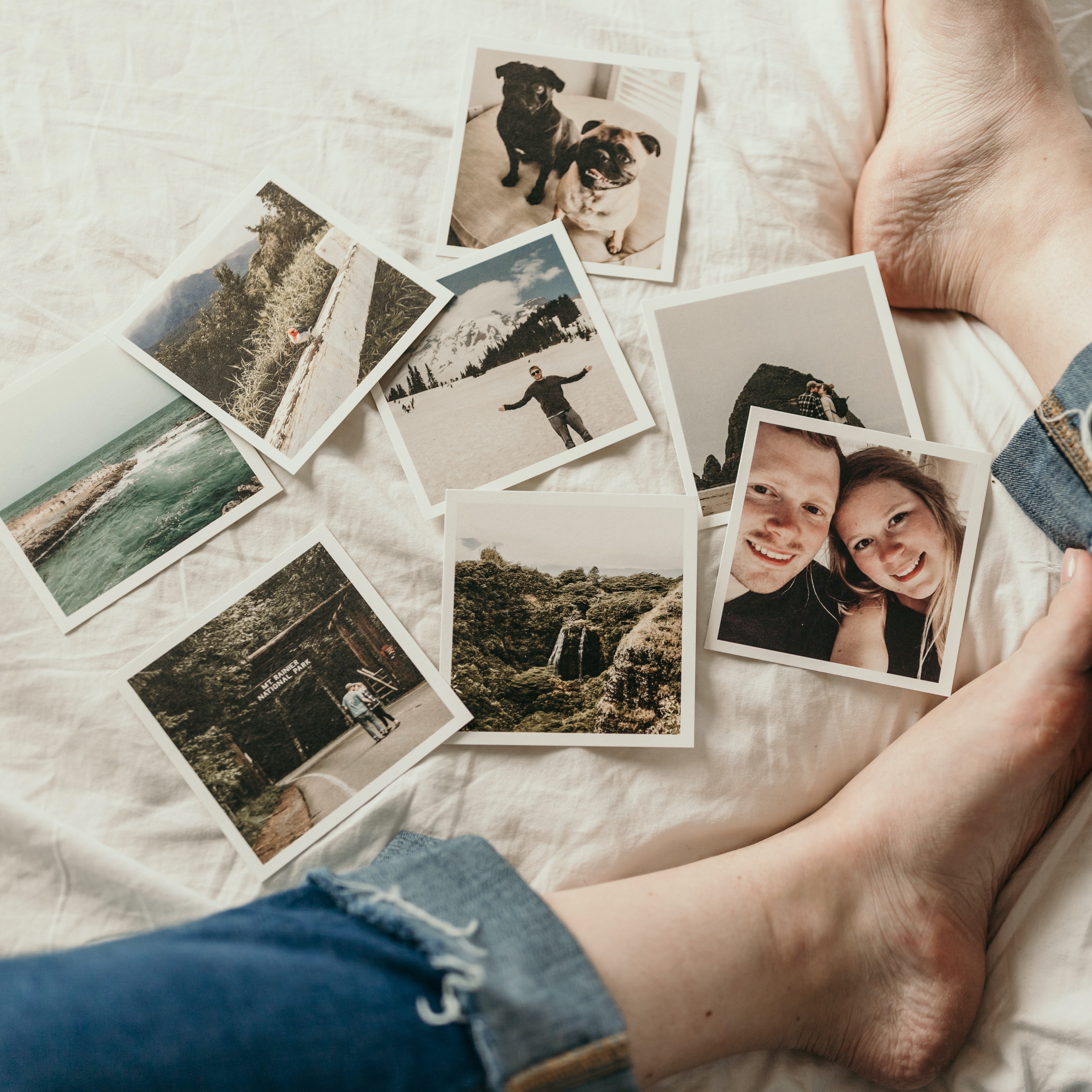Bénéficiez d'une livraison forfaitaire pour seulement 10 $ et de la livraison gratuite pour les commandes de plus de 150 $* lorsque vous réalisez des impressions de vos œuvres d'art et peintures originales avec Posterjack. Commencer aujourd'hui!

Que vous soyez un artiste cherchant à reproduire vos peintures originales pour les revendre ou que vous recherchiez simplement un moyen de réaliser une impression de votre œuvre pour l'offrir à un ami ou à un membre de votre famille, vous n'avez pas besoin d'accéder à un équipement de numérisation sophistiqué ou du matériel photographique coûteux pour obtenir des impressions de qualité professionnelle.
En fait, en suivant quelques conseils, vous pouvez même obtenir de belles impressions de votre art en utilisant uniquement votre smartphone ! Cet article vous apprendra à photographier vos œuvres d'art comme un pro, afin que vos tirages soient absolument incroyables.
Est-il préférable de numériser ou de photographier des œuvres d’art ?
Si vous avez accès à un scanner et que votre œuvre peut être numérisée, ce sera probablement votre meilleure option, car il sera plus facile de reproduire votre œuvre avec une plus grande précision et vous n'aurez pas à vous soucier de la distorsion, des ombres, de l'image. flou ou d'autres problèmes que vous pouvez rencontrer lorsque vous essayez de photographier des œuvres d'art. Cela dit, numériser vos œuvres d'art peut être difficile, voire impossible, selon le support et la taille. Les œuvres d'art comportant beaucoup de textures et/ou d'embellissements ne seront probablement pas numérisées correctement, car vous perdrez une grande partie de la profondeur et de la dimension de l'œuvre d'art originale. Si la taille de votre illustration est plus grande que celle du scanner, vous devrez la numériser en sections, puis utiliser un logiciel d'édition, comme Photoshop, pour assembler le tout. Dans ces cas-là, photographier vos œuvres d’art pour les imprimer pourrait être une meilleure option.
Si vous décidez de numériser vos illustrations pour créer des impressions, voici quelques conseils (partagés à l'origine dans Comment agrandir d'anciennes photos et obtenir des résultats étonnants ) :
En fonction de la marque et du modèle de votre scanner, les étapes exactes à suivre pour numériser votre œuvre varient, mais il s'agira probablement simplement de placer l'œuvre face vers le bas sur la vitre du scanner et d'appuyer sur le bouton de numérisation. Cependant, avant de numériser, vous devez vérifier quelques paramètres pour vous assurer que vous obtiendrez la meilleure numérisation possible afin de créer des impressions de votre œuvre d'art.
Mode couleur : assurez-vous de numériser en couleur, et non en noir et blanc ou en niveaux de gris.
Résolution (DPI) : pour numériser des illustrations à des fins d'impression, la résolution doit être réglée sur 300 dpi.
Format de données/type de fichier : JPEG
Une fois que vous avez numérisé votre illustration en utilisant ces paramètres, elle est prête à être imprimée. Tout ce que vous avez à faire maintenant est de télécharger le fichier sur notre site Web et de choisir le produit et la taille avec lesquels vous souhaitez que votre impression soit créée et nous nous occuperons de là !
Connexes : Préserver les œuvres d'art de vos enfants avec Posterjack
Comment photographier des œuvres d'art pour des impressions
Si l'utilisation d'un scanner pour reproduire votre œuvre n'est pas une option, vous pouvez toujours obtenir des résultats d'aspect professionnel en photographiant votre œuvre pour des impressions.
Option 1 : Utiliser un smartphone pour prendre des photos de votre art

Idéalement, lorsque vous photographiez vos œuvres d'art pour des impressions, vous devriez utiliser un appareil photo reflex numérique, car vous aurez plus d'options et de contrôle sur les paramètres et le capteur et l'objectif de l'appareil photo produiront de meilleures images. Cependant, si tout ce à quoi vous avez accès est un smartphone, vous pouvez toujours prendre des photos de vos œuvres d'art qui donneront lieu à des impressions fantastiques ! Suivez les conseils d'éclairage et de composition ci-dessous, comme vous le feriez avec un appareil photo reflex numérique, mais si vous utilisez un smartphone, n'oubliez pas de nettoyer l'objectif. Parce que nos téléphones sont constamment entre nos mains, mis dans et hors de nos poches, peut-être même manipulés par les petits doigts collants de nos petits humains, l'objectif du téléphone capte facilement les empreintes digitales, les huiles et la crasse. Prenez une seconde pour l'essuyer avec un chiffon avant de photographier votre œuvre d'art afin de vous assurer d'obtenir l'image la plus nette et la plus claire possible.
Option 2 : Utiliser un appareil photo reflex numérique pour prendre des photos de votre art
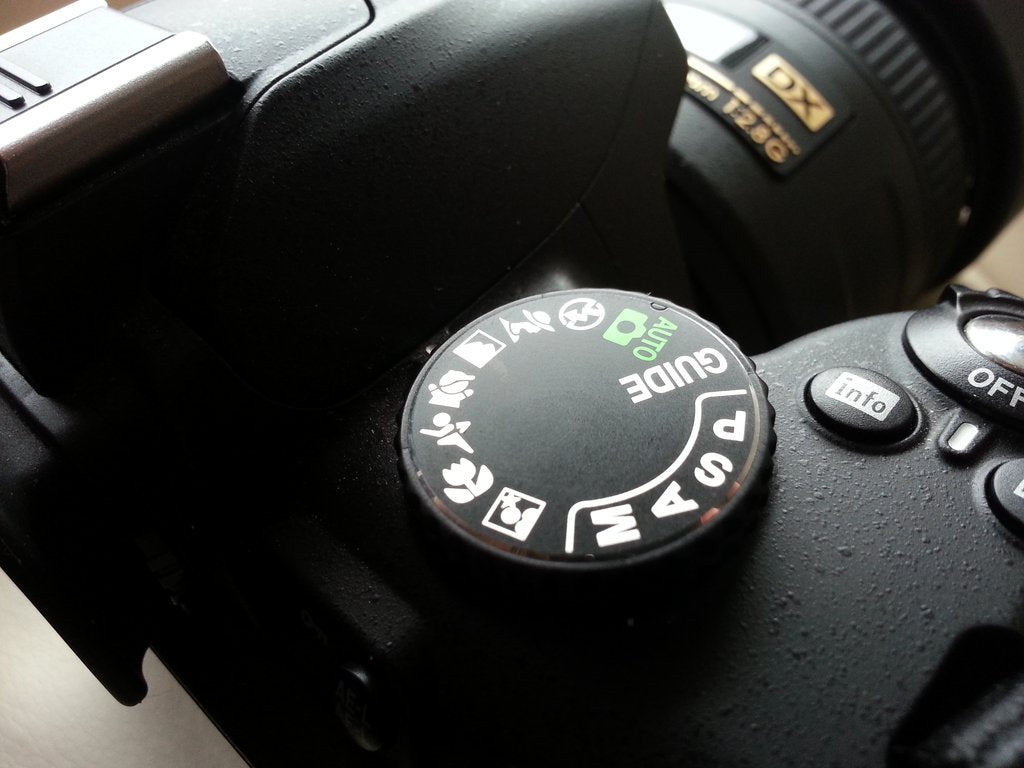
Comme nous venons de le mentionner, capturer des photos de vos œuvres à l'aide d'un appareil photo reflex numérique est une meilleure option que d'utiliser l'appareil photo d'un smartphone, car cela produira des images plus nettes et vous aurez plus de contrôle sur vos paramètres.
Objectif : Un objectif principal de 50 mm est idéal pour photographier des œuvres d’art. Si vous devez utiliser un objectif avec une distance focale plus courte, essayez d’éviter tout ce qui est inférieur à 24 mm. La prise de vue avec un objectif grand angle peut provoquer une distorsion en barillet, ce qui signifie que les lignes droites de votre œuvre sembleront se plier sur la photo.
Ouverture : Les images les plus nettes sont produites avec l’ouverture réglée entre f/5,6 et f/11. L'utilisation d'une grande ouverture crée une faible profondeur de champ, ce qui n'est pas nécessaire pour photographier des œuvres d'art, et la diffraction de l'objectif diminuera la netteté de votre image si vous photographiez à une valeur bien supérieure à f/11.
Connexe : Comprendre la profondeur de champ
ISO : les paramètres ISO contrôlent la sensibilité du capteur de votre appareil photo à la lumière. Un ISO élevé laisse entrer plus de lumière, ce qui est idéal lors de prises de vue dans des conditions de faible luminosité , mais le résultat est le bruit et le grain de l'image dans la photo - quelque chose que vous ne voulez pas lorsque vous photographiez des œuvres d'art pour créer des tirages ! Pour obtenir l'image la plus nette possible, réglez l'ISO de votre appareil photo sur 100.
Balance des blancs : lorsque vous prenez des photos de votre œuvre d’art pour créer des impressions, vous souhaitez que les couleurs de l’image soient aussi proches que possible de l’œuvre originale. Le réglage des paramètres de balance des blancs de votre appareil photo sera d'une grande aide, car il permettra à votre appareil photo de savoir quelles sources de lumière sont utilisées et ajustera les températures de couleur en conséquence. Si vous ne savez pas quel réglage choisir, n'hésitez pas à expérimenter et à en essayer quelques-uns ! Vous pouvez également régler la balance des blancs ultérieurement à l’aide d’un logiciel de retouche photo.
Configurer votre éclairage en 5 étapes
Des équipements spécialisés, comme des softbox et des filtres polarisants, peuvent faciliter la photographie de vos œuvres d'art, mais vous pouvez vous passer de ces accessoires tout en obtenant des résultats exceptionnels. En fait, vous pouvez réussir à prendre des photos de vos œuvres d'art sans lumières de studio ni trépied, mais nous y reviendrons dans un instant.
Pour une séance photo en intérieur, vous aurez besoin de :
- Un trépied
- Deux lumières vives et identiques
- Un mur pour accrocher vos œuvres
- Mètre ruban
Facultatif, mais utile :
- Deux feuilles blanches (ou quelque chose de similaire pour diffuser chaque lumière)
- Déclencheur à distance de l'appareil photo
- Morceau de papier blanc
- Niveau
Étape 1 : Si votre œuvre est dans un cadre, vous devrez la retirer afin d'éviter les reflets et les reflets. De même, si vous envisagez d'ajouter du vernis à votre œuvre d'art originale, photographiez-la avant de le faire si possible.
Étape 2 : Accrochez votre œuvre à plat au mur. En supposant que votre œuvre ne soit pas trop lourde, une punaise devrait faire l'affaire, car elle ne restera pas là longtemps. Si vous avez un niveau, vérifiez qu'il est droit. Si vous envisagez de modifier votre image plus tard pour ajuster ses couleurs et sa balance des blancs, envisagez d'accrocher votre œuvre contre un mur d'un blanc pur ou simplement d'accrocher un morceau de papier blanc directement à côté de votre œuvre (il sera recadré plus tard). Cela vous permettra d'utiliser l'outil Pipette de votre logiciel d'édition pour ajuster la balance des blancs ultérieurement.
Étape 3 : Placez votre appareil photo sur un trépied à distance de l'œuvre d'art, ce qui vous permet de remplir le cadre de l'appareil photo sans avoir besoin de zoomer optiquement ou numériquement. Lorsque vous composez la photo, même si vous souhaitez remplir votre cadre, ne le faites pas trop étroitement - si vous incluez environ un pouce d'arrière-plan derrière votre illustration, cela facilitera un peu l'édition de votre photo plus tard puisque vous le ferez. être capable de faire pivoter/redresser la photo sans qu'aucune illustration ne soit recadrée au cours du processus.
Étape 4 : Lors du positionnement de votre appareil photo, il est très important que l'objectif de l'appareil photo soit parallèle à l'œuvre d'art et que l'objectif de l'appareil photo et le centre de l'œuvre d'art soient à la même hauteur. Utilisez un ruban à mesurer pour mesurer du sol au centre de l'œuvre d'art, puis ajustez la hauteur de votre appareil photo pour qu'elle soit la même. Si la hauteur n'est pas la même ou si l'appareil photo est incliné par rapport à l'œuvre, votre photographie de votre œuvre sera déformée.

Étape 5 : Une fois votre illustration et votre caméra configurées, vous pouvez maintenant positionner vos lumières. Vous voulez qu’ils soient dirigés vers votre œuvre d’art et à un angle de 45º de chaque côté de la caméra. Même si vos lumières doivent être brillantes, vous obtiendrez de meilleurs résultats si vous parvenez à diffuser l'éclairage. Vous pouvez le faire simplement en accrochant un drap blanc devant chaque lumière. Si vous n'avez pas de draps blancs, vous pouvez expérimenter avec d'autres objets blancs semi-transparents que vous pouvez trouver dans la maison, comme des t-shirts, du papier parchemin ou ciré, des sacs poubelles blancs ou même du papier d'imprimante.
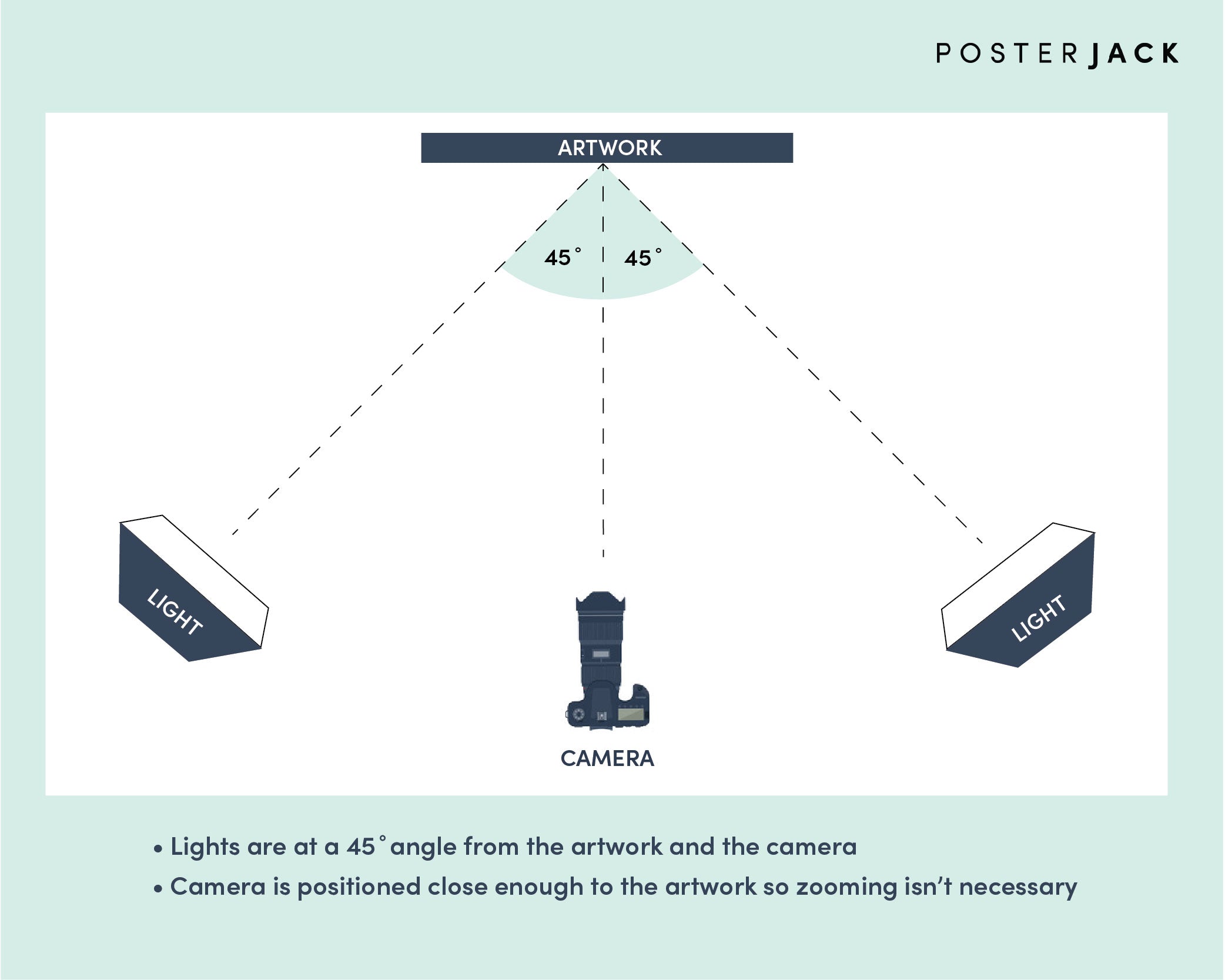
Important : Les lumières peuvent devenir chaudes et le matériau que vous utilisez peut être inflammable, alors faites attention à ne pas installer vos diffuseurs là où ils pourraient prendre feu !
Conseils pour photographier l’art
- Si vous photographiez en intérieur avec les paramètres ISO de votre appareil photo à 100, votre appareil photo a besoin de plus de lumière externe pour prendre de bonnes photos. Utilisez les lumières les plus brillantes possibles (avec un diffuseur). En laissant plus de lumière entrer dans le capteur de votre appareil photo, vous obtiendrez une image plus nette et de meilleure qualité.
- Pour obtenir les images les plus nettes possibles, il est important de maintenir votre appareil photo aussi stable que possible. Si vous n'avez pas de trépied, placez votre appareil photo sur une table. Vous pouvez également empiler des livres sur la table pour régler votre appareil photo à la bonne hauteur.
- Appuyer sur le déclencheur de votre appareil photo peut même vous faire perdre la netteté de votre photo. Utilisez un déclencheur à distance si vous en avez un ou réglez la minuterie de votre appareil photo pour ne pas avoir à appuyer manuellement sur le déclencheur.
- N'utilisez pas le flash de votre appareil photo.
- Si vous n'avez pas de lumière à utiliser comme dans la configuration ci-dessus, vous pouvez photographier votre œuvre d'art avec succès en extérieur en utilisant la lumière naturelle ! Une journée nuageuse est la meilleure solution, car les nuages diffusent naturellement la lumière. À défaut, lorsque vous photographiez en extérieur, trouvez un endroit ombragé sur le côté de votre maison ou d’une autre grande structure. Vous voulez éviter la lumière directe du soleil, car elle projetterait des ombres sur votre œuvre d’art.
Conseils pour modifier vos photos d’œuvres d’art avant l’impression
Lors de l'édition des photos de votre œuvre d'art, quelques étapes de post-traitement que vous pouvez prendre en compte sont :
Redressage : si nécessaire, faites pivoter votre image pour qu'elle soit complètement droite. C'est pourquoi nous vous recommandons d'inclure environ un pouce d'arrière-plan derrière votre illustration lors de la composition de votre photo. La rotation numérique de l'image sans cet espace supplémentaire couperait une partie de l'œuvre d'art.
Recadrage : une fois que vous avez ajusté votre photo pour qu'elle soit droite, vous pouvez continuer et recadrer l'arrière-plan. Vous ne voulez rien voir dans l'image, à l'exception de votre chef-d'œuvre lorsque vous créez des impressions de qualité professionnelle de votre œuvre originale !
Correction des couleurs : vous pouvez régler la balance des blancs, le contraste, la luminosité et la netteté de votre image, mais n'en faites pas trop ! Vous souhaitez que votre image soit aussi proche que possible de l’œuvre d’art originale.
Faire des impressions de vos œuvres d'art
Maintenant que vous avez créé des copies numériques de votre œuvre originale, il est temps de passer à la partie amusante : réaliser des impressions ! Nous proposons une grande variété de produits d’art photographique, mais en voici quelques-uns qui méritent d’être pris en compte et qui sont populaires auprès des artistes.
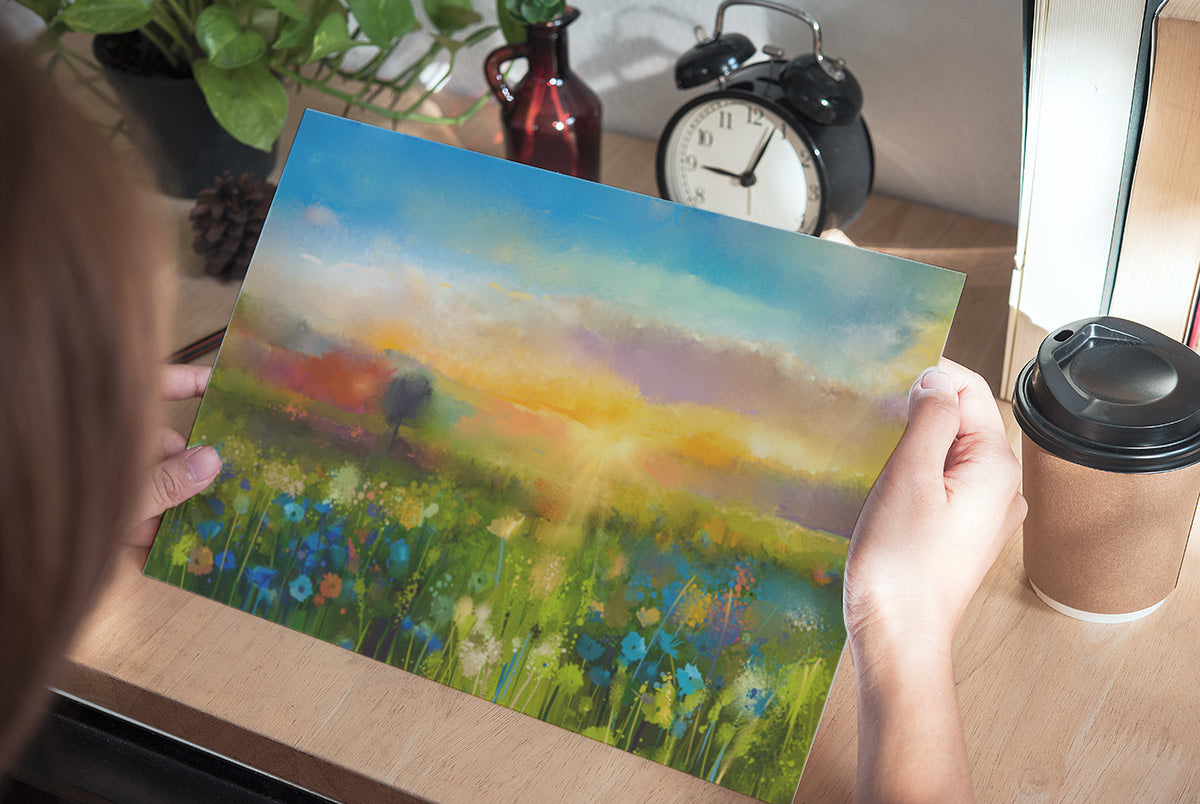
Les tirages d'art Posterjack sont réalisés avec du Hahnemuehle Photo Rag 100 % coton 308 g/m², l'un des meilleurs papiers d'art au monde. En utilisant la méthode giclée (jet d'encre), nous utilisons des encres HP Vivera non toxiques et respectueuses de l'environnement et un logiciel d'impression exclusif, afin que vos impressions soient éclatantes et belles. Ils sont également considérés comme résistants à la décoloration pendant plus de 200 ans ! Ils sont disponibles dans plus de 40 tailles différentes, et vous pouvez même les faire encadrer sur mesure dans l'un des six styles de cadre différents. Si vous envisagez d'imprimer votre œuvre d'art sur quelque chose comme de la toile, du métal ou de l'acrylique, mais que vous souhaitez d'abord imprimer un échantillon pour vous assurer que vous êtes satisfait de la photo de votre œuvre, les tirages d'art sont également parfaits à cet effet.
Une impression acrylique Posterjack est une œuvre d’art photographique personnalisée réalisée avec des matériaux de qualité supérieure. Depuis notre atelier de Toronto, nous imprimons votre photo directement sur du verre acrylique optiquement transparent de 1/4 de pouce d'épaisseur en utilisant la méthode giclée. Une fois votre photo imprimée sur l'acrylique, nos experts en art photographique la montent sur une feuille de support protectrice blanche, puis la terminent en polissant les bords pour obtenir un éclat cristallin. C'est notre produit phare, et pour cause ! Découvrez Qu'est-ce qu'une impression acrylique pour en savoir plus à leur sujet.

Bien que nous proposons trois types différents de tirages métalliques, chacun avec ses propres caractéristiques uniques, nos tirages métalliques blanc mat sont une option populaire pour l'impression d'œuvres d'art en raison de leur finition satinée mate. Ils sont parfaits pour être exposés dans presque toutes les situations, y compris les pièces avec des lumières vives ou un éclairage zénithal. Ils sont résistants à la décoloration pendant plus de 200 ans et sont imprimés à l'aide d'un équipement d'impression SwissQ avancé pour une qualité d'image supérieure. Votre œuvre sera imprimée sur un panneau en aluminium recouvert de blanc de 3 mm et vous pourrez choisir l'une des quatre options de suspension : support flottant, kit d'entretoise, cadre flottant moderne ou cadre standard. Aucune option de suspension/encadrement n'est également disponible.
Connexes : Tout ce que vous devez savoir sur les impressions métalliques
Les impressions sur toile Posterjack sont étirées à la main et fabriquées ici même au Canada, à partir de notre site de Toronto. Notre objectif est de fournir aux Canadiens les meilleures impressions sur toile disponibles, ce qui signifie que nous utilisons uniquement des matériaux de qualité supérieure comme une toile épaisse en polycoton qui ne s'affaisse pas et des cadres en tilleul canadien séchés au four qui ne se déforment pas. En plus de garantir que les matériaux que nous utilisons sont sans égal, nous déployons tout autant d’efforts pour garantir que vos œuvres d’art soient à leur meilleur ! Nous imprimons des photos à l'aide de notre logiciel exclusif PJ-PRINT™ et d'imprimantes de classe mondiale utilisant des encres HP certifiées vertes qui ne se décoloreront pas pendant 200 ans. La qualité et le soin que nous mettons dans la création de nos impressions sur toile signifient que vous obtenez une belle œuvre d'art personnalisée que vous pourrez fièrement afficher sur votre mur et des années plus tard, elle sera tout aussi vibrante que le jour où vous l'avez reçue.

Si vous ne parvenez pas à décider sur quoi vous souhaitez imprimer votre œuvre, vous pouvez commander une boîte d'échantillons , qui comprend une variété de matériaux sur lesquels nous imprimons, ainsi qu'un chèque-cadeau de 10 $ à utiliser lors de votre prochaine commande.
